 France (1899-1927) – Armored Cruisers: Dupleix, Desaix, Kléber
France (1899-1927) – Armored Cruisers: Dupleix, Desaix, KléberWW1 French Cruisers
Sfax | Tage | Amiral Cecille | D'Iberville class | Dunois class | Foudre | Davout | Suchet | Forbin class | Troude class | Alger class | Friant class | Linois class | Descartes class | D'Assas class | D’Entrecasteaux | Protet class | Guichen | Chateaurenault | Chateaurenault | D'Estrées class | Jurien de la Graviere | Lamotte-Picquet classDupuy de Lome | Amiral Charner class | Pothuau | Jeanne d'Arc | Gueydon class | Dupleix class | Gloire class | Gambetta class | Jules Michelet | Ernest Renan | Edgar Quinet class
The Dupleix class consisted armored cruisers of the Marine Nationale were designed for overseas service (hence three ships for three stations, Atlantic, Mediterranean and Far East). They were armed with eight 164.7 mm (6.5 in) guns, smaller and less powerful compared to their predecessors but with a more rational hull, better speed and range. Kléber hit a mine and sank in 1917, the two other survived the war and were scrapped in 1922-27. #marinenationale #ww1 #frenchnavy #armouredcruiser #dupleix #desaix #kleber
Design of the class
Hull and general design
The Dupleix-class cruisers were much smaller, lightly armed than Jeanne d’Arc at 132.1 meters (433 ft 5 in) overall in lenght, 17.8 meters (58 ft 5 in) in beam, mean draft of 7.46 meters (24 ft 6 in) and a 7,700 metric tons (7,578 long tons) designed standard displacement. Since they were intened for colonial stations, reducing biofouling imposed a hull teak sheating. The crew comprised 19 officers and 550 ratings with flagship accomodations for 5 more officers and 33 more personal.
Their appareance diverged significantly for previous three-funnel, stockier, plough bow armoured cruisers of the 1st generation, and were more a reduced version of the Jeanne d’Arc, but with four funnels far apart. They had this typical lozenge artillery style, but little to now tumblehome, a reasonable bow combining a clipper-ram curve, an pointed stern for overall fine lines and greater speed than her predecessors, add to a more favourable length/beam ratio. Their superstructures were minimalistic, with an enclosed bridge with wings and open one on top, built above the conning tower. There were two equal size masts supporting wireless telegraphic cables, the former being thinker to support a large spotting top, with projector on top.
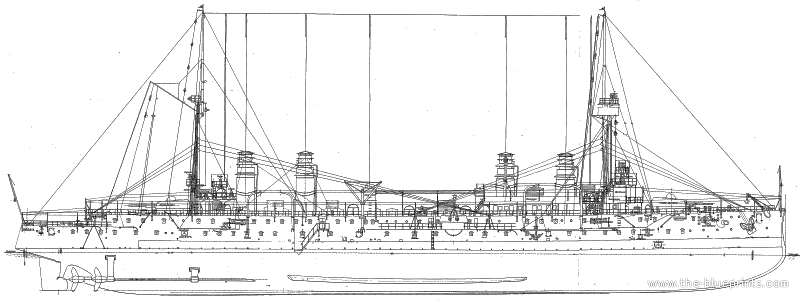
Desaix in 1914. She was painted in a medium grey overall livery. Note: Original archive blueprints did not survived, they are not online as far as i know, despite being made all open source material.
Powerplant
The three cruisers had a mostly similar propulsion machinery, varying between yard’s choices for boilers and in detail. They all had three shafts and three vertical triple-expansion (VTE) steam engines, each driving its own four-bladed own bronze propeller shaft. Steam was provided by a vaired numbers of water-tube boilers, dependng on their provenance, size and type:
-Dupleix and Desaix were given four-cylinder VTE engines, and the same 24 Belleville boilers at a working pressure of 20 kg/cm2 (1,961 kPa; 284 psi)
-Kléber (Girone Yard) had three-cylinder VTE engines and 20 Niclausse boilers working at 18 kg/cm2 (1,765 kPa; 256 psi).
As designed thet were all to reach an ouptut of 17,100 metric horsepower (12,600 kW) for a top speed of 21 knots (39 km/h; 24 mph).
Of course this diverged at speed trials: They all exceeding their designed output but speed was disappointing, Kléber only meeting or exceeded it in sea trials, reching speeds up to 20.6–21.5 knots (38.2–39.8 km/h; 23.7–24.7 mph) based on 17,177 to 17,870 metric horsepower (12,634–13,143 kW). Desaix and Dupleix were below 21 knots on trials. They all carried the same 1,200 metric tons (1,200 long tons; 1,300 short tons) of coal to achieve their optimal range of 6,450 nautical miles (11,950 km; 7,420 mi) at 10 knots cruising speed.
Protection
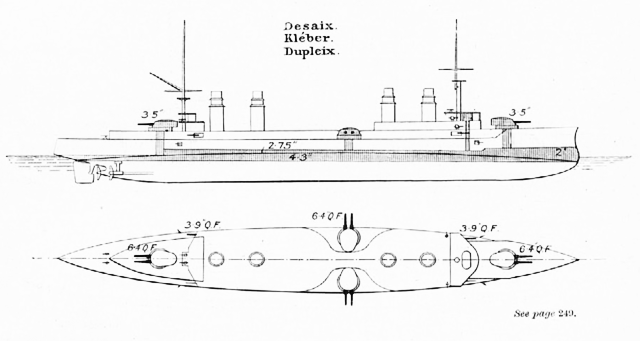
Protection scheme on Brassey’s naval annual 1904
The ships were not very well protected, more as a compromise between armoured and armoured cruisers proper. This was however nickel steel used for the armor belt, 102 millimeters (4 in) thick, extended from 1.2 meters (3 ft 11 in) below the waterline and 1.995 meters (6 ft 7 in) above the waterline so over 3.2 meters (10.5 feet) in height complementary to the turtledeck style armour deck. The belt only stopped 18.9 meters (62 feet) short of the stern, closed there by a transverse bulkhead, 84 mm (3.3 in) in thickness. It was also thinned down to 84 mm (3.3 in) in front of the forward turret and then 38 mm (1.5 in) at the lower edge, close to the armoured deck.
The curved protective deck measured 42 mm (1.7 in) in thickness at its flat section, up to 70 millimeters (2.8 in) when curving down to the belt, and meeting the bottom edge of the latter. Behind it, engineers subdivided the space in watertight internal cofferdam, that can be filled with coal or left empty.
The gun turrets were of double conical shape (top-bottom) and protected by 110 mm (4.3 in) of Harvey face-hardened armor covering the front and sides, thined down back, and with roofs of just 20 mm (0.79 in). The barbettes wells below reached 120 mm (4.7 in) thick, down to the main armour deck. The conning tower (CT) forward (none aft) was elliptical and with walls ranginf from 100 to 120 mm in thickness (4 to 5 in).
Armament
Main
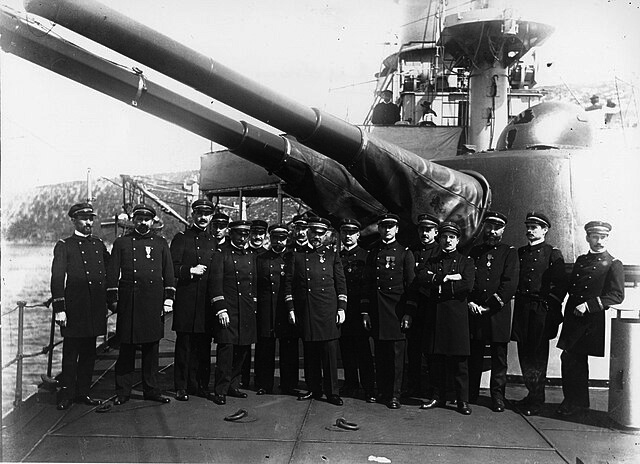
Main battery and crew posing on Kléber
The Dupleix class cruiser’s main armament looked very modern and could have been worth of 1920-30s designs with four twin turrets. Alas, they were not placed in superfing pairs, as stability was a great concerns at the time, as well as doctrine. One tradition that was firmly engrained in French naval construction for major ships at the time, was the trademark lozenge configuration.
Thus these eight quick-firing (QF) 45-caliber Canon de 164 mm Modèle 1893–96 guns had the four twin-gun turrets mounted forward and aft in axis, and the remainder amidships, which obliged designers to create a very narrow superstructure section where they were placed in order to clear it when firing a broadside, at 90°.
The 164 mm (6.45 inches) cannons fired 54.9-kg (121 lb) shells at 865 meters per second (2,840 ft/s) for a range of c10,800 meters (11,800 yd) at +15 degrees elevation. 200 rounds shells were provisioned for each gun, including 44 ready rounds stowed in the turrets themselves, ensuring a three rounds per minute fire rate. To compare the contemporary Vickers QF 6-in/40 fired at 5-7 rounds per minute but range was 10,000 yards (9,140 m) at 20°.
Secondary
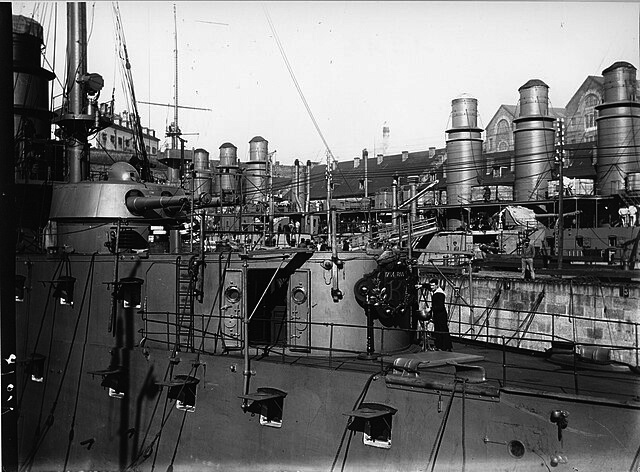
Aft section of Kléber, showing the turret and lower stern deck with casemates
The secondary armament was diversified, “sampled”, starting four QF Canon de 100 mm Modèle 1893, 45 caliber (3.9 inches), all on single mounts, in unprotected casemates in the hull. Two forward, with recesses, two aft, also with the recesses formed by the end of the battery deck to the lower weather one. They were in the unprotected part of the hull.
They fired 16-kg (35 lb) shells at 710 meters per second (2,300 ft/s) in muzzle velocity, with a rate of fire on average of six rounds a minute. Maximum elevation was +20 degrees, good for casemated guns, enough for a range of 9,000 meters (9,800 yd). Traverse wa slimited to about 80° or less. They each were assigned 250 rounds, closed to the casemate.
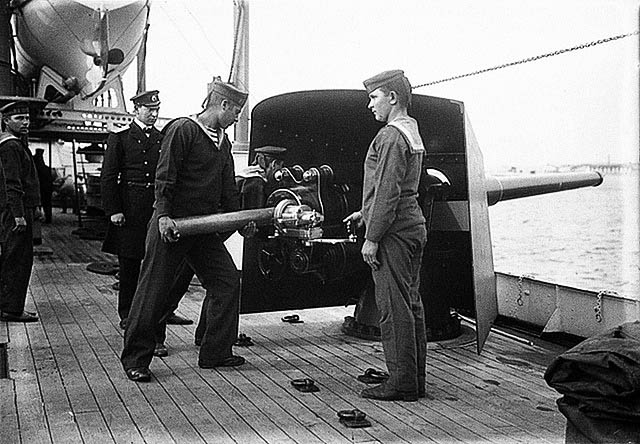
100 mm/45 model 1893 (3.9 inches) in a shielded variant. They were in casemates in these ships.
Next were their close defense guns against incoming torpedo boats, ten 47 mm/40 (1.9 in) modele 1885 plus four 37 mm (1.5 in)/20 modele 1885, all Hotchkiss guns, all placed on single mounts around the ship and partly shielded. According to the blueprints, four of the 47 mm were in lower casemates fore and aft (useless in heavy weather) with limited traverse, and eight on the bridge and aft strcture, with the rest also mounted on platforms, also on the bridge and aft structures, or on deck.
As a reminder the the 47 m (in RN service, QF 3-pdr) had 30 rpm, MV 571 m/s (1,870 ft/s), max range 5.9 km (3.7 mi) at +20°.
The 37 mm were of the revolver type, six barreled, for quick firing.
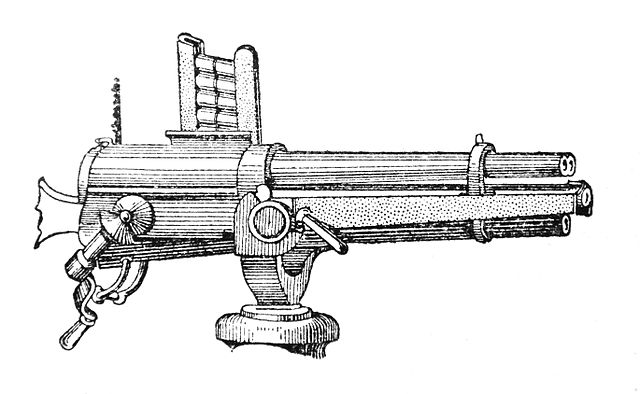
Hotchkiss 37 mm (1 pdr) revolver cannons
The three cruisers also had as usual two above-water 450 mm (17.7 in) torpedo tubes mounted on broadsides.
After this, no changes except for Desaix which in 1917 saw the removal of her four useless 100mm/45 casemate gun and addtion instead of two single Hotchkiss 47mm/50 M1902 in anti-aicraft mounts for 80° elevaiton.

⚙ specifications as built |
|
| Displacement | 7,700 t (7,578 long tons) |
| Dimensions | 132.1 x 17.8 x 7.46 m (433 ft 5 in x 58 ft 5 in x 24 ft 6 in) |
| Propulsion | 3 shafts TE steam engines, 20-24 WT boilers 17,100 PS (12,600 kW) |
| Speed | 21 knots (39 km/h; 24 mph) |
| Range | 6,450 nmi (11,950 km; 7,420 mi) at 10 knots |
| Armament | 4×2 164.7 mm, 4×1 100 mm, 10×1 47 mm, 4×1 37 mm, 2× 450 mm torpedo tubes |
| Protection | Belt 84–102, Turrets 110, Barbettes 80–120, Deck 42–70, Bulkheads 40 or 84, CT 100–120 mm |
| Crew | 19/24* officers and 550/583* men (*as flagship) |
Read More/Src
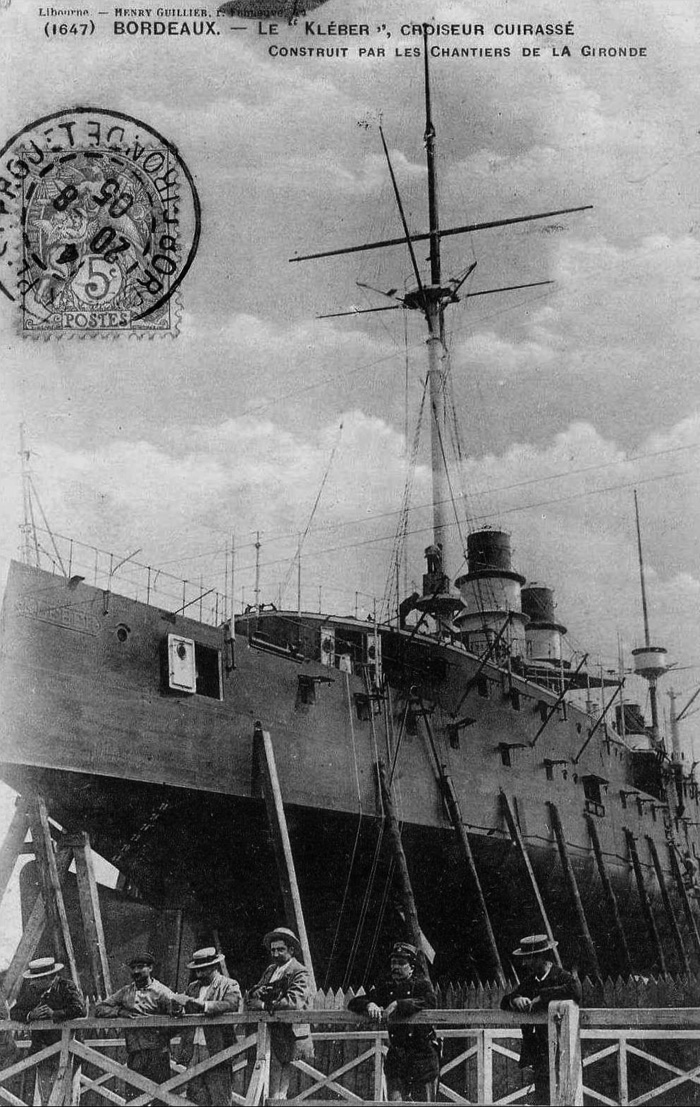
Kléber prior to launch, FC Gironde Yards.
Books
Chesneau, Roger & Kolesnik, Eugene M., eds. (1979). Conway’s All the World’s Fighting Ships 1860–1905. Conway.
Corbett, Julian (1997). Naval Operations to the Battle of the Falklands. Based on Official Documents. Vol. IWM
Corbett, Julian (1997). Naval Operations. Vol. III (2nd ed.). IWM association with the Battery Press.
Dai, Wei (September 2020). “A Discussion on French Armored Cruiser Identification: From the Gueydon Class to the Edgar Quinet Class”. Warship International. LVII (3)
Friedman, Norman (2011). Naval Weapons of World War One: Guns, Torpedoes, Mines and ASW Weapons of All Nations. Barnsley, UK: Seaforth.
Jordan, John & Caresse, Philippe (2019). French Armoured Cruisers 1887–1932. Barnsley, UK: Seaforth Publishing.
Ropp, Theodore (1987). Roberts, Stephen S. (ed.). The Development of a Modern Navy: French Naval Policy, 1871–1904. NIP
Sieche, Erwin F. (1990). “Austria-Hungary’s Last Visit to the USA”. Warship International. XXVII (2): 142–164.
Silverstone, Paul H. (1984). Directory of the World’s Capital Ships. New York: Hippocrene Books.
Links
https://www.battleships-cruisers.co.uk/dupleix_class.htm
https://en.wikipedia.org/wiki/Dupleix-class_cruiser
http://navypedia.org/ships/france/fr_cr_dupleix.htm
Model Kits
Not a lot of choice BUT A NICE ONE: Kombrig 1/700 in 1903, 1:350.
 Dupleix
Dupleix
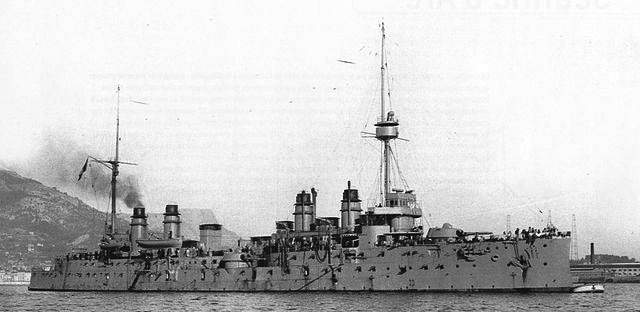
Dupleix in Toulon, M Bar coll. wikimedia cc
Dupleix (after Joseph François Dupleix, XVIIIth Governor-General of French India) was ordered at Arsenal de Rochefort, Atlantic coast, on 18 December 1897. Laid down on 18 January 1899, launched on 28 April 1900, she sea trials took only place by 15 March 1903, after two years of completion, for a total of seven years, usual for French Yards at the time although she suffered delays: Preliminary trials in 1902 saw a boiler accident on 22 August (seven stokers badly burnt) and later on 30 September she had high-pressure engine cylinders cracking during a 24-hour trial so repairs with replacement bopilers and cylinders were necessary, and new testing for a total of eight months. She was commissioned on 15 September 1903 under a 16,308,850 francs cost, artillery included.
In service she was flagship of the Atlantic Division (hence the facilities) and cruised to the Azores, West Africa, Americas and while back she was placed in reserve in 1906 but reactivated in 1910, and assigned to the Far Eastern Division in Indochina, also as flagship. She left Cherbourg on 12 November 1910 for Saigon and stayed there until the war broke up. Replaced by the armored cruiser Montcalm, she was soon detached for several wartime missions in the Pacific.
She departed already Japan on 29 July for British Hong Kong (5 August) assigned to the British China Squadron, following agreed allied pre-war plans. She escorted the dreadnought battleship HMS Triumph northwards, taking part in the blockade of Qingdao (Tsingtao) soon joined with the IJN. However engine problems prevented her chase of the SMS Emden after the Imperial Japanese Navy took over the siege on 9 September. Instead she was sent to Penang for patrol duties with French in the Strait of Malacca, a possible exit gate for Von spee’s Pacific fleet. She entered the drydock as soon as practicable to have her engines repaired. By late September she started escorting convoys into the Red Sea, and from Egypt to India.
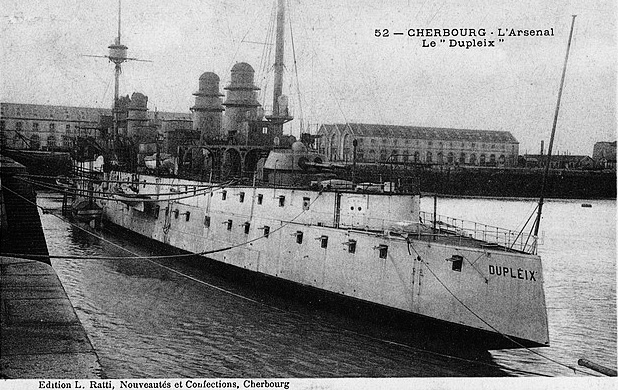
Dupleix in Cherbourg, 1900
Dupleix was ordered newt to join the newly formed Dardanelles Squadron by May 1915, on the Aegean coast, but while closing on the shore for attack Turkish position in the early days of the naval bombardment, on the 26th, she was targeted by the Bodrum battery while inspecting shipping and had 27 killed, 11 wounded by a hit. With the rampage of German merchant raiders she was retired and transferred after repairs to the Atlantic as escort. She joined the all-French 6th Light Division (6e Division légère) with her three sisters by July 1916, based in Dakar in French West Africa to escort mid-Atlantic and south african traffic.
Manpower being needed for better patrol boats, the division was reduced to Dupleix and Desaix, renamed “Coast of Africa Division” on 18 May 1917 under RADM Louis Jaurès, flagship Dupleix. Disbanded on 14 September, Dupleix was sent to Brest, placed in reserve on 15 October and stayed there until decommissioned on 1 May 1919, stricken on 27 September, towed in Britanny in 1920, sold and BU in 1922.
 Desaix
Desaix
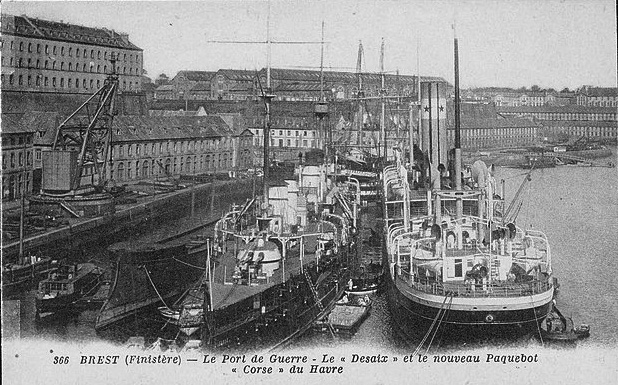
Desaix in Brest, Britanny, WWI
Desaix was named after French Revolutionary General Louis Desaix, and ordered from Ateliers et Chantiers de la Loire, on 28 December 1897. Armament configuration was revised after being laid down and contract revised accoridng to changes made in 3 September 1899, creating much delays. Construction resumed in Nantes, Arlantic coast, by early 1899 until launched on 21 March 1901, with sea trials on 6 August 1902 and commission on 5 April 1904 at a total cost of 19,068,975 francs.
She was assigned to the Mediterranean Fleet, Light Squadron, with her sister Kléber. She relieved Dupleix as flagship of the Atlantic Division in September 1905 and then Kléber in the Light Squadron, back in Toulon by November 1906, and then the Atlantic Division again in 1908, placed in reserve in 1909, and reactivated in 1914.
The July Crisis saw Desaix and Kléber reactivated, assigned to the 3rd Light Division, 2nd Light Squadron to defend the English Channel as agreed with the RN. The 3rd DL was kept at the western end of the Channel on 4 August and were authorized to patrol and intercept German shipping and cover escorts for transports carrying on the other side John French’s British Expeditionary Force.
As Channel defences were improved, the cruisers were relieved in early 1915 Desaix being reassigned to the 3rd Squadron, Eastern Mediterranean, on 16 February. She patrolled between Port Said and Alexandretta in Syria. In May she assisted the 1re Armée Navale (1st naval army) in the Central Mediterranean, looking for German shipping trapped in May 1915 or still trading from and to Italian ports, neutral until their entry in the war.
Desaix stayed off Palermo in Sicily from 18 May to 6 June, and returned to the 2nd DL to patrol between Capo Colonna (southern Italy) and and Crete. She was assigned to the 3rd Squadron for a blockade of the Ottoman coast from Latakia in Syria to Mersin with the cruiser Guichen and seaplane carrier Foudre. They notably rescued numerous Armenian refugees fleeing the Ottomans near Antioch in Syria by 12–13 September.
Successes of the Möwe in 1916 had new cruisers ordered to the Atlantic for escorting convoys and Desaix joined the 6th DL in Dakar on April 1916, then Coast of Africa Division on 18 May 1917 until disbanded on 14 September, and she was placed in reserve in Dakar, until resuming convoy escorts in the South Atlantic until November 1918. Back home for a refit, she was reassigned to the Far Eastern Division in 1919 until back in France on 31 March 1921, decommissioned for good, stricken on 27 July, sold in 1927.
 Kléber
Kléber
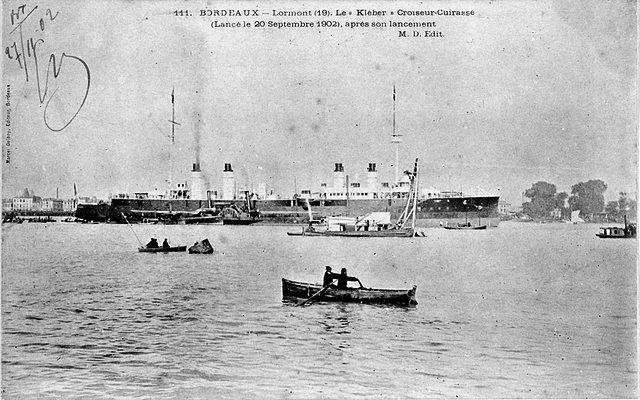
Launch of Kleber and completion at Chantiers de la Gironde, Lormont.
Kléber was named after French Revolutionary-era General Jean-Baptiste Kléber, ordered from Forges et Chantiers de la Gironde estuary, near Bordeaux on 28 December 1897. Construction was delayed when like for her sisters when the armament configuration was revised, contract changed on 22 August 1899, she was launched on 20 September 1902 but struck the river bottom due to improper tide evaluation. She started her sea trials on 26 September, was repaired, completed new trials until commissioned on 4 July 1904 at a cost 19,258,000 francs.
Kléber joined the Mediterranean Fleet’s Light Squadron upon completion with her sister Desaix, transferred in September 1905, back in squadron by November 1906 and replacing Kléber which was reassigned to the Atlantic as flagship of the Antilles Division (French West Indies). When visiting the United States, she accidentally rammed the 2,183-gross register ton (GRT) steamer Hugoma on the Mississippi River, off New Orleans by 20 February 1907. The latter sank in shallow water. Damage to the cruiser’s bow was insignificant and she resumed her trip. On 20 May Kléber was in New York City with the more recent cruiser Victor Hugo and Chasseloup-Laubat for an official parade, then they departed for Jamestown for the Exposition and naval review, overviewed by President Theodore Roosevelt, on 10 June.
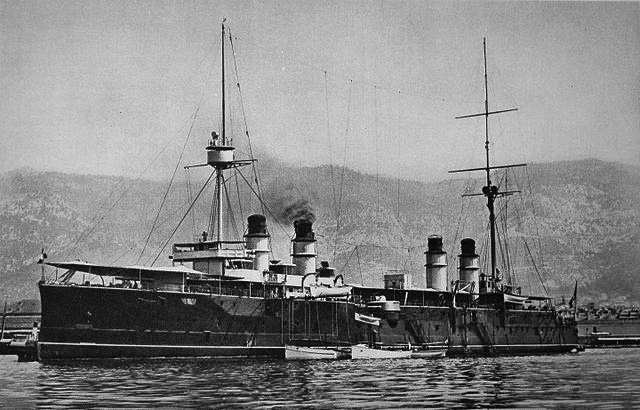
Kleber in Toulon before the war, M Bar coll. wikimedia cc
In January 1908 Kléber was reassigned to the Mediterranean as flagship of the Moroccan Division, but in reserve by 1909 until 1911, reactivated and reassigned to the Far East Naval Division with Dupleix. There she struck an uncharted reef on 12 July 1912, being drydocked and repaired at Kobe in Japan, before sailing back to Lorient in France and by January 1913 replaced in reserve.
Reactivated in 1914, she was assigned to the 3rd Light Division, 2nd Light Squadron in the English Channel, western end but by late September she teamed with Gloire and Gueydon south off the southern coast of Brittany.
In 1915 Kléber was transferred to the Dardanelles and the Gallipoli Campaign by 16 May with the dedicated squadron. She ran aground off Scala Nuova Bay, targeted by coastal artillery until she could free herself. With Dupleix, Bruix and Latouche-Tréville she was sent instead to blockade the Asia Minor coast, and stayed off Lesbos until colliding with RAN troopship HMT Boorara in the Aegean Sea, 17 July 1915. Boorara was beached on Mudros to avoid sunking but Kléber had a mushed bow, and sailed out for repairs;
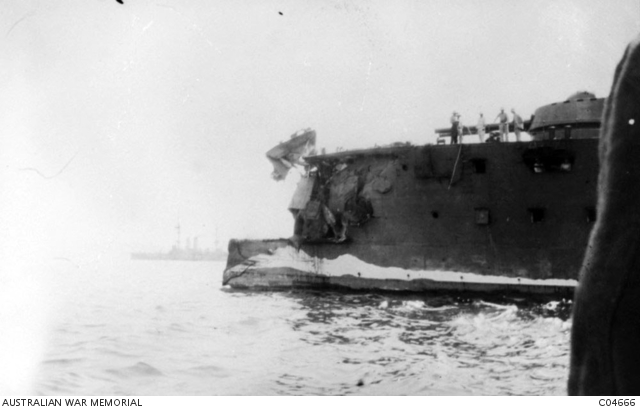
Kléber mushed bow after her collision
With Bulgaria at war by mid-October, Kléber and the Russian cruiser Askold plus four destroyers was sent to hunt shipping on the Aegean coast of Bulgaria (Dedeagatch to Porto Lago), with shelling the railroad junction at Dedeagatch on 21 October. Like her sister however she was retraindferred to escort convoy in mid and south atlantic from Dakar from July 1916 at Dakar,, then Coast of Africa Division. Kléber was sent back to Brest, but underway she hit a mine at 06:00 on 27 June (from UC-61) in the Iroise entrance to Brest. The detonation was abreast her forward boiler rooms, and sho lost half power only her aft boilers providing steam still for 20 more minutes? The floding ultimately forced her bulkheads and at 06:30 this became untrollable, she was abandoned, but too late, she capsized and sank with almost all hands. Only 38 of the crew was resued by fishing trawlers, French TB and British steamship.

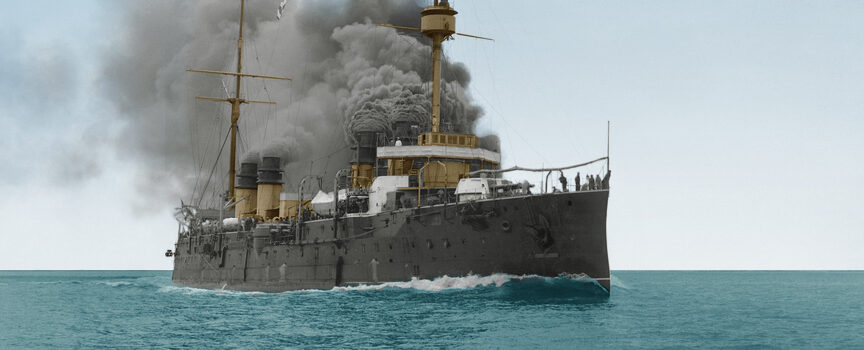
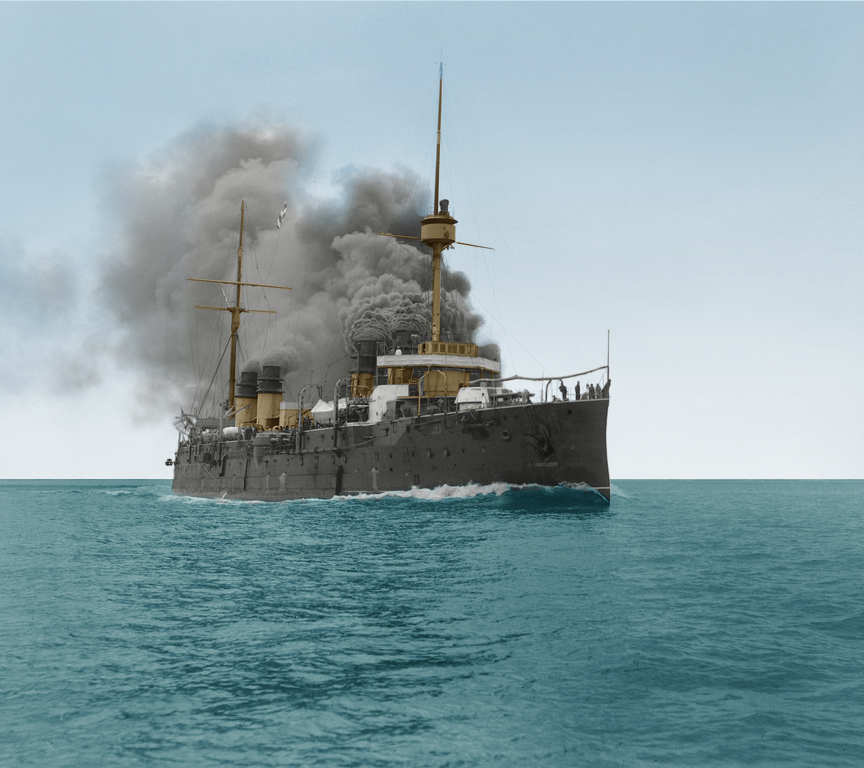
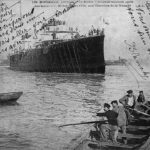
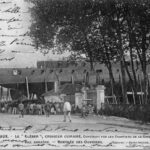
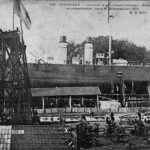
 Latest Facebook Entry -
Latest Facebook Entry -  X(Tweeter) Naval Encyclopedia's deck archive
X(Tweeter) Naval Encyclopedia's deck archive Instagram (@navalencyc)
Instagram (@navalencyc)





 French Navy
French Navy Royal Navy
Royal Navy Russian Navy
Russian Navy Armada Espanola
Armada Espanola Austrian Navy
Austrian Navy K.u.K. Kriegsmarine
K.u.K. Kriegsmarine Dansk Marine
Dansk Marine Nautiko Hellenon
Nautiko Hellenon Koninklije Marine 1870
Koninklije Marine 1870 Marinha do Brasil
Marinha do Brasil Osmanlı Donanması
Osmanlı Donanması Marina Do Peru
Marina Do Peru Marinha do Portugal
Marinha do Portugal Regia Marina 1870
Regia Marina 1870 Nihhon Kaigun 1870
Nihhon Kaigun 1870 Preußische Marine 1870
Preußische Marine 1870 Russkiy Flot 1870
Russkiy Flot 1870 Svenska marinen
Svenska marinen Søværnet
Søværnet Union Navy
Union Navy Confederate Navy
Confederate Navy Armada de Argentina
Armada de Argentina Imperial Chinese Navy
Imperial Chinese Navy Marinha do Portugal
Marinha do Portugal Mexico
Mexico Kaiserliche Marine
Kaiserliche Marine 1898 US Navy
1898 US Navy Sovietskiy Flot
Sovietskiy Flot Royal Canadian Navy
Royal Canadian Navy Royal Australian Navy
Royal Australian Navy RNZN Fleet
RNZN Fleet Chinese Navy 1937
Chinese Navy 1937 Kriegsmarine
Kriegsmarine Chilean Navy
Chilean Navy Danish Navy
Danish Navy Finnish Navy
Finnish Navy Hellenic Navy
Hellenic Navy Polish Navy
Polish Navy Romanian Navy
Romanian Navy Turkish Navy
Turkish Navy Royal Yugoslav Navy
Royal Yugoslav Navy Royal Thai Navy
Royal Thai Navy Minor Navies
Minor Navies Albania
Albania Austria
Austria Belgium
Belgium Columbia
Columbia Costa Rica
Costa Rica Cuba
Cuba Czechoslovakia
Czechoslovakia Dominican Republic
Dominican Republic Haiti
Haiti Hungary
Hungary Honduras
Honduras Estonia
Estonia Iceland
Iceland Eire
Eire Equador
Equador Iran
Iran Iraq
Iraq Latvia
Latvia Liberia
Liberia Lithuania
Lithuania Mandchukuo
Mandchukuo Morocco
Morocco Nicaragua
Nicaragua Persia
Persia San Salvador
San Salvador Sarawak
Sarawak Uruguay
Uruguay Venezuela
Venezuela Zanzibar
Zanzibar Warsaw Pact Navies
Warsaw Pact Navies Bulgaria
Bulgaria Hungary
Hungary

 Bundesmarine
Bundesmarine Dutch Navy
Dutch Navy Hellenic Navy
Hellenic Navy Marina Militare
Marina Militare Yugoslav Navy
Yugoslav Navy Chinese Navy
Chinese Navy Indian Navy
Indian Navy Indonesian Navy
Indonesian Navy JMSDF
JMSDF North Korean Navy
North Korean Navy Pakistani Navy
Pakistani Navy Philippines Navy
Philippines Navy ROKN
ROKN Rep. of Singapore Navy
Rep. of Singapore Navy Taiwanese Navy
Taiwanese Navy IDF Navy
IDF Navy Saudi Navy
Saudi Navy Royal New Zealand Navy
Royal New Zealand Navy Egyptian Navy
Egyptian Navy South African Navy
South African Navy






























 Ukrainian Navy
Ukrainian Navy dbodesign
dbodesign